Rock Fragmentation Characteristics by TBM Cutting and Efficiency under Bi-Lateral Confinement
Abstract
:1. Introduction
2. Test Methodology
2.1. Equipment
2.1.1. Penetration Platform
2.1.2. Tunnel Boring Machine Disc Cutters
2.1.3. Surface Profilometer
2.2. Specimen Preparation
2.3. Test Design and Procedure
2.3.1. Test Design
2.3.2. Testing Process
- Based on the true triaxial test, five steps are designed as follows:
- 1.1.
- To prevent stress between the pads and specimen surface, the contact surface and pad surface are properly coated before forwarding the specimen into the loading area, as shown in Figure 4.
- 1.2.
- Loads equal to 10 kN are applied in the longitudinal and transverse directions. Confining loadings are proportionally applied to loads σ2 and σ1 to the set value when the previous loading is stabilized.
- 1.3.
- Once the confining pressure is loaded, the stress in the transverse direction is loaded to 100 N using the stress control to ensure that the loading unit in Z-direction is in full contact with the top of the disc cutters. After applying the load (100 N) in the transverse direction, displacement is used to control the penetration rate of the disc cutters while the penetration depth and force variations are recorded. The penetration energy is calculated by integrating the force values.
- 1.4.
- When the penetration depth reaches 6 mm, penetration and recording the data should be stopped, and the stress in the transverse direction is unloaded. Once the unloading in the transverse direction has ended, the load in the longitudinal direction is removed.
- 1.5.
- The specimen is rotated and steps (2) to (5) are repeated for the second penetration test.
- Scanning the fractured surfaceThe specimens, which are assessed by the penetration test, are placed on the tray upon the profilometer, the fractured surface generated after the penetration is scanned, and the built-in software is used to calculate the volume of the fractured surface.
- Using a fully automatic rock cutting machine, the rock specimens are cut along the ABC plane (see Figure 4) to assess the development of internal cracks. In order to decrease the influence of cutting on the crack development, the thickness and speed of the cutting blade are set to 1 mm and 5 cm/min, respectively.
3. Results
3.1. Fractured Surface Morphology Analysis
3.1.1. Variations of Fractured Surface with Increase of Major Confining Pressure while Minor Confining Pressure is Constant
3.1.2. Variation of Fractured Surface once Minor Confining Pressure Increases, while Major Confining Pressure is Constant
3.2. Crack Development between Disc Cutters
3.2.1. Variations of Crack Development with Increase of Major Confining Pressure while Minor Confining Pressure is Constant
3.2.2. Variation of Crack Development with Increase of Minor Confining Pressure while Major Confining Pressure is Constant
4. Discussion
4.1. Penetration Energy under Different Confining Pressures
4.2. Volume of the Fractured Surface under Different Confining Pressures
4.3. Breaking Efficiency under Different Confining Pressures
5. Conclusions
- The fractured surface gradually developed when σ1 was constant and σ2 increased. The rock crushing mechanism varied from the shear failure in the shallow surface to the tensile failure in the bottom, and the efficiency of rock breaking gradually increased.
- The depth and volume of the fractured surface gradually decreased, and the failure mode varied from tensile failure to shear failure, resulting in a decrease in rock-breaking efficiency when σ2 was constant and σ1 increased.
- When σ1 was constant, the energy consumption efficiency gradually increased with an increase in σ2. Although some fluctuations were observed, the overall energy consumption increased with the increase in σ2. When σ2 was constant, the energy consumption gradually increased with an increase in σ1.
- Edge effects played a significant role in experimental performance. Large-scale sample tests provided insight into the characteristics of rock breaking. In the present study, whether it affects the experimental results or not is out of our research area. We plan to survey the edge effect in a future study.
Acknowledgments
Author Contributions
Conflicts of Interest
References
- Ozdemir, L.; Wang, F.D. Mechanical Tunnel Boring Prediction and Machine Design; Colorado School of Mines: Golden, CO, USA, 1979. [Google Scholar]
- Gertsch, R.E. Rock Toughness and Disc Cutting; University of Missouri: Columbia, MO, USA, 2000. [Google Scholar]
- Eftekhari, M.; Baghbanan, A.; Bagherpour, R. The effect of fracture patterns on penetration rate of TBM in fractured rock mass using probabilistic numerical approach. Arab. J. Geosci. 2013, 7, 5321–5331. [Google Scholar] [CrossRef]
- Bakar, M.Z.A.; Gertsch, L.S.; Rostami, J. Evaluation of fragments from disc cutting of dry and saturated sandstone. Rock Mech. Rock Eng. 2014, 47, 1891–1903. [Google Scholar] [CrossRef]
- Gong, Q.-M.; Zhao, J. Development of a rock mass characteristics model for TBM penetration rate prediction. Int. J. Rock Mech. Min. Sci. 2009, 46, 8–18. [Google Scholar] [CrossRef]
- Yagiz, S. Utilizing rock mass properties for predicting TBM performance in hard rock condition. Tunn. Undergr. Space Technol. 2008, 23, 326–339. [Google Scholar] [CrossRef]
- Gong, Q.-M.; Zhao, J.; Jiao, Y.-Y. Numerical modeling of the effects of joint orientation on rock fragmentation by TBM cutters. Tunn. Undergr. Space Technol. 2005, 20, 183–191. [Google Scholar] [CrossRef]
- Gong, Q.-M.; Zhao, J. Influence of rock brittleness on TBM penetration rate in Singapore granite. Tunn. Undergr. Space Technol. 2007, 22, 317–324. [Google Scholar] [CrossRef]
- Wang, S.Y.; Sloan, S.W.; Liu, H.Y.; Tang, C.A. Numerical simulation of the rock fragmentation process induced by two drill bits subjected to static and dynamic (impact) loading. Int. J. Rock Mech. Min. Sci. 2011, 44, 317–332. [Google Scholar] [CrossRef]
- Goldsmith, W.; Wu, W. Response of rocks to impact loading by bars with pointed ends. Rock Mech. 1981, 13, 157–184. [Google Scholar] [CrossRef]
- Tan, Q.; Xu, Z.-J.; Xia, Y.-M.; Zhang, K. Numerical study on mode of breaking rock by TBM cutter in two cutting orders. J. Cent. South Univ. 2012, 43, 940–946. [Google Scholar]
- Hadi, H.; Mohammad, F.M.; Kourosh, S. Simulating the effects of disc erosion in TBM DISC cutters by a semi-infinite DDM. Arab. J. Geosci. 2014, 6, 3915–3927. [Google Scholar]
- Huo, J.; Hou, N.; Sun, W.; Wang, L.; Dong, J. Analyses of dynamic characteristics and structure optimization of tunnel boring machine cutter system with multi-joint surface. Nonlinear Dyn. 2017, 87, 237–254. [Google Scholar] [CrossRef]
- Huo, J.; Zhu, D.; Hou, N.; Sun, W.; Dong, J. Application of a small-timescale fatigue, crack-growth model to the plane stress/strain transition in predicting the lifetime of a tunnel-boring-machine cutter head. Eng. Fail. Anal. 2016, 71, 11–30. [Google Scholar] [CrossRef]
- Huo, J.; Wu, H.; Sun, W.; Zhang, Z.; Wang, L.; Dong, J. Electromechanical coupling dynamics of TBM main drive system. Nonlinear Dyn. 2017, 90, 2687–2710. [Google Scholar] [CrossRef]
- Huo, J.; Wang, W.; Sun, W.; Ling, J.; Dong, J. The multi-stage rock fragmentation load prediction model of tunnel boring machine cutter group based on dense core theory. Int. J. Adv. Manuf. Technol. 2017, 90, 277–289. [Google Scholar] [CrossRef]
- Gong, Q.M.; She, Q.R.; Hou, Z.S.; Jiang, H.; Peng, Q. Experimental study of TBM penetration in marble rock mass under high geostress. Chin. J. Rock Mech. Eng. 2010, 29, 2522–2532. [Google Scholar]
- Yin, L.J.; Gong, Q.M.; Zhao, J. Study on rock mass boreability by TBM penetration test under different in situ stress conditions. Tunn. Undergr. Space Technol. 2014, 43, 413–425. [Google Scholar] [CrossRef]
- Tarkoy, P.J.; Marconi, M. Difficult rock comminution and associated geological conditions. In Proceedings of the International Symposium: Tunnelling ’91, London, UK, 14–18 April 1991; pp. 195–207. [Google Scholar]
- Bilgin, N.; Tuncdemir, H.; Balci, C.; Copur, H.; Eskikaya, S. A model to predict the performance of tunneling machines under stressed conditions. In Proceedings of the AITES-ITA 2000 World Tunnel Congress, Durban, South Africa, 13–17 May 2000; pp. 47–54. [Google Scholar]
- Innaurato, N.I.; Oggeri, C.; Oreste, P.P.; Vinai, R. Experimental and numerical studies on rock breaking with TBM tools under high stress confinement. Rock Mech. Rock Eng. 2007, 40, 429–451. [Google Scholar] [CrossRef]
- Huang, H.; Damjanal, B.; Detournay, E. Normal wedge indentation in rocks with lateral confinement. Rock Mech. Rock Eng. 1998, 31, 81–94. [Google Scholar] [CrossRef]
- Cook, N.G.; Hood, M.; Tsai, F. Observation of crack growth in hard rock loaded by an indenter. Int. J. Rock Mech. Min. Sci. 1984, 21, 97–107. [Google Scholar] [CrossRef]
- Liu, H.Y.; Kou, S.Q.; Lindqvist, P.A.; Tang, C.A. Numerical simulation of the rock fragmentation process induced by indenters. Int. J. Rock Mech. Min. Sci. 2002, 39, 491–505. [Google Scholar] [CrossRef]
- Ma, H.-S.; Yin, L.-J.; Ji, H.-G. Numerical study of the effect of confining stress on rock fragmentation by TBM cutters. Int. J. Rock Mech. Min. Sci. 2011, 48, 1021–1033. [Google Scholar] [CrossRef]
- Balci, C. Correlation of rock cutting tests with field performance of a TBM in a highly fractured rock formation: A case study in Kozyatagi-Kadikoy metro tunnel, Turkey. Tunn. Undergr. Space Technol. 2009, 24, 423–435. [Google Scholar] [CrossRef]
- Chang, S.H.; Choi, S.W.; Bae, G.J. Performance prediction of TBM disc cutting on granitic rock by the linear cutting test. Tunn. Undergr. Space Technol. 2006, 21, 271. [Google Scholar] [CrossRef]
- Li, M.H.; Yin, G.Z.; Xu, J.; Li, W.; Song, Z.; Jiang, C. A novel true triaxial apparatus to study the geomechanical and fluid flow aspects of energy exploitations in geological formations. Rock Mech. Rock Eng. 2016, 49, 4647–4659. [Google Scholar] [CrossRef]
- Yin, L.J.; Gong, Q.M.; Ma, H.S.; Zhao, J.; Zhao, X.B. Use of indentation tests to study the influence of confining stress on rock fragmentation by a TBM cutter. Int. J. Rock Mech. Min. Sci. 2014, 72, 261–276. [Google Scholar] [CrossRef]
- Gertsch, R.; Gertsch, L.; Rostami, J. DISC cutting tests in Colorado red granite: Implications for TBM performance prediction. Int. J. Rock Mech. Min. Sci. 2007, 44, 238–246. [Google Scholar] [CrossRef]
- Bejari, H.; Hamidi, J.K. Simultaneous effects of joint spacing and orientation on TBM cutting efficiency in jointed rock masses. Rock Mech. Rock Eng. 2013, 46, 897–907. [Google Scholar] [CrossRef]
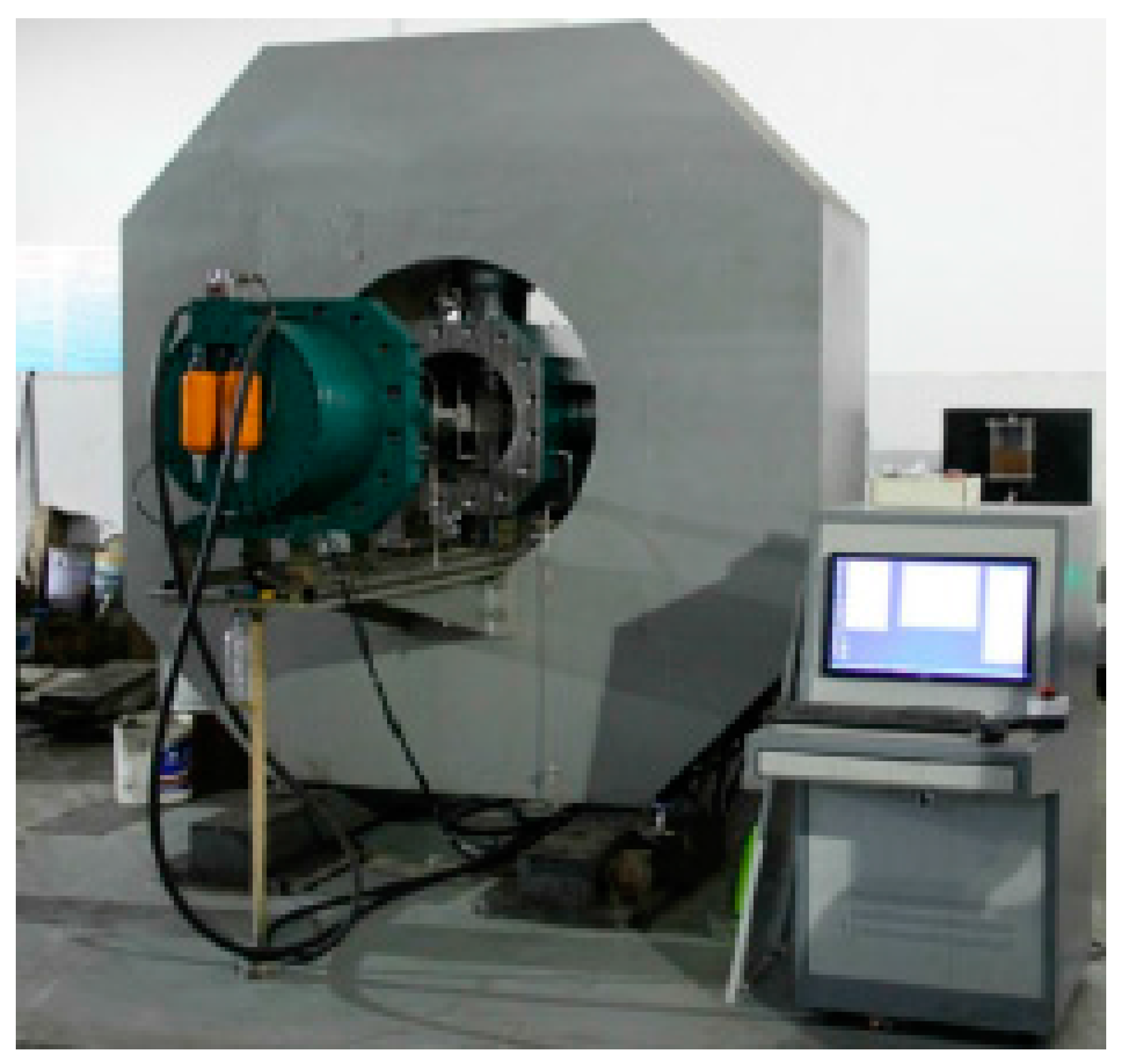
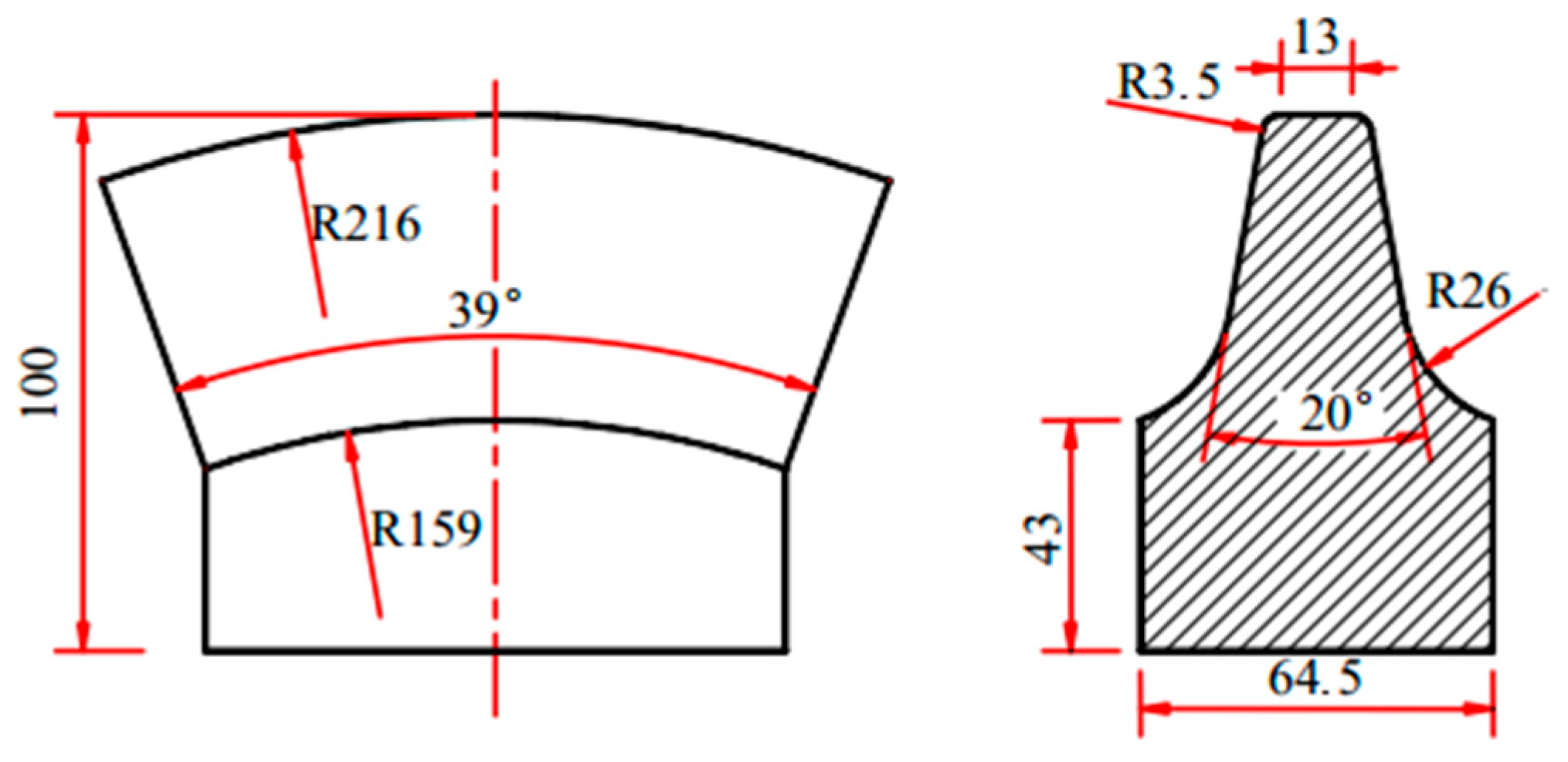

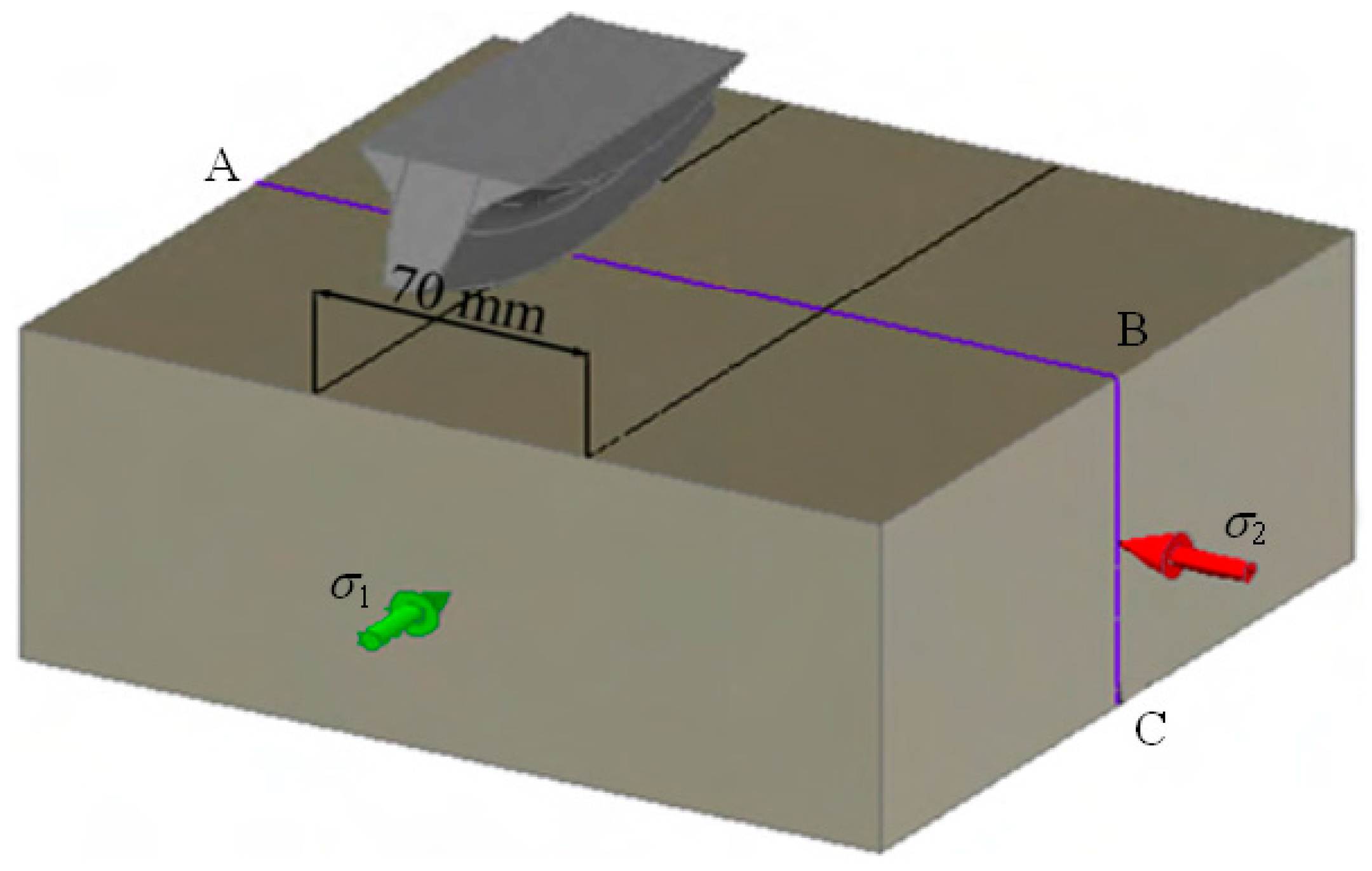
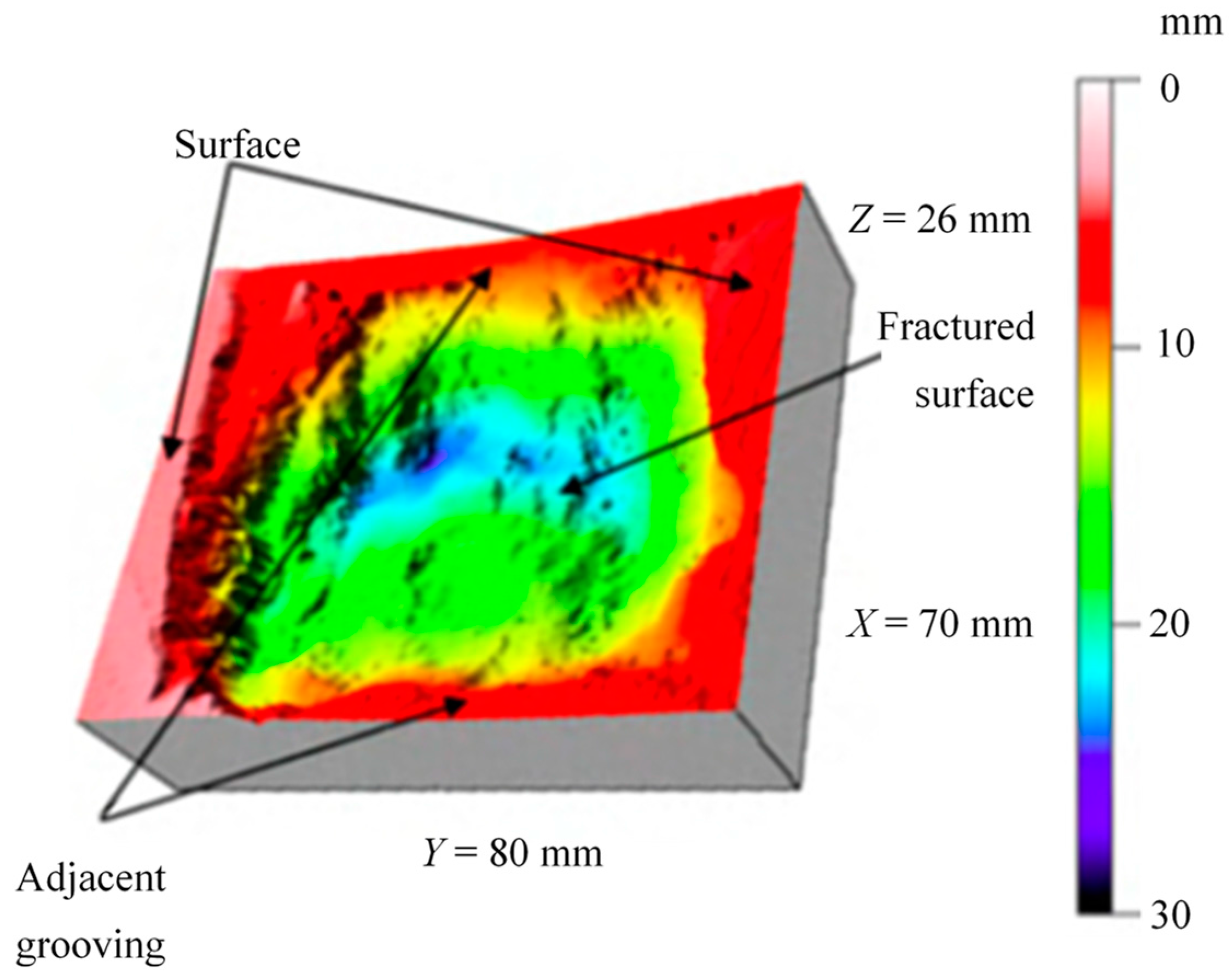

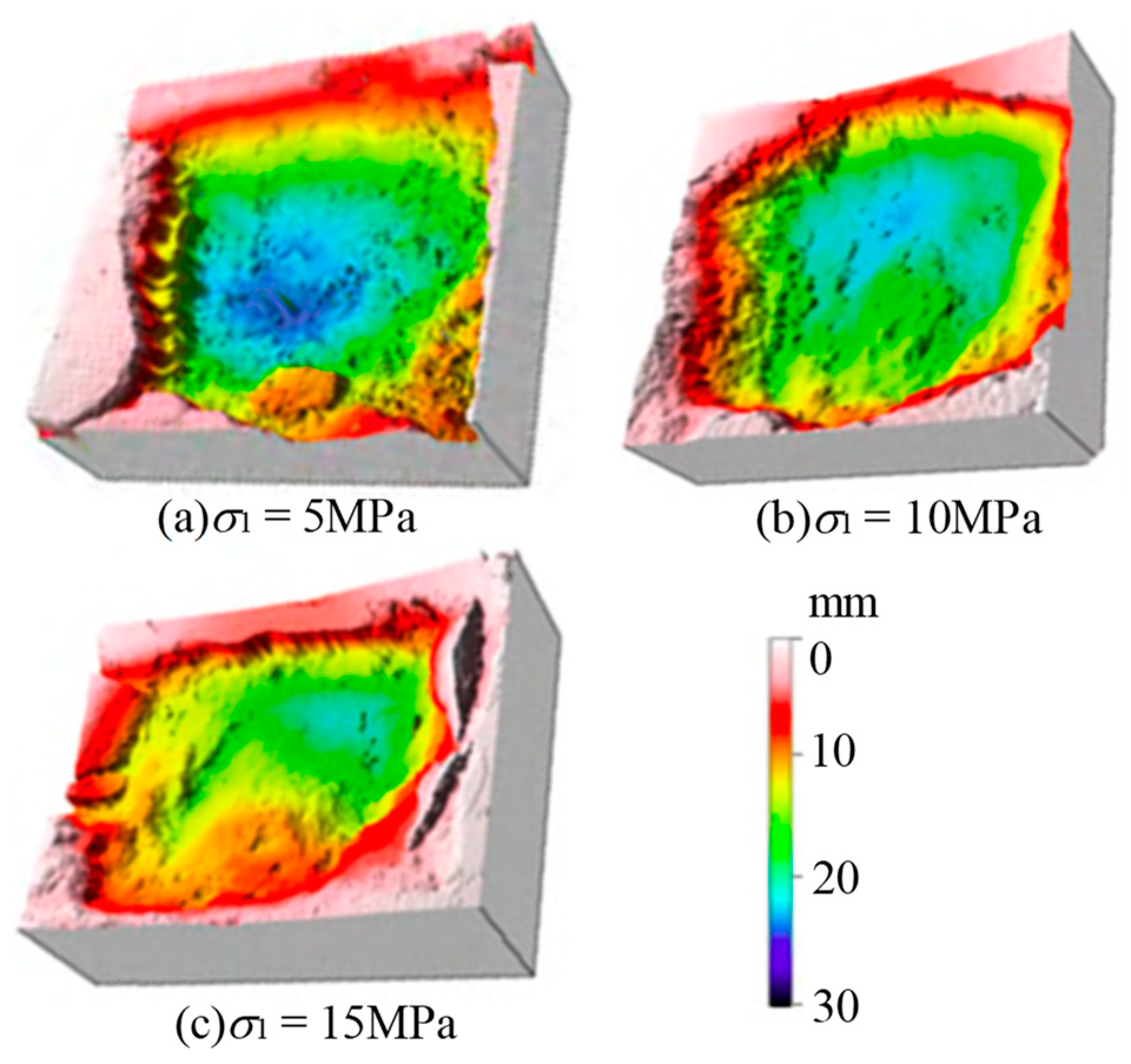

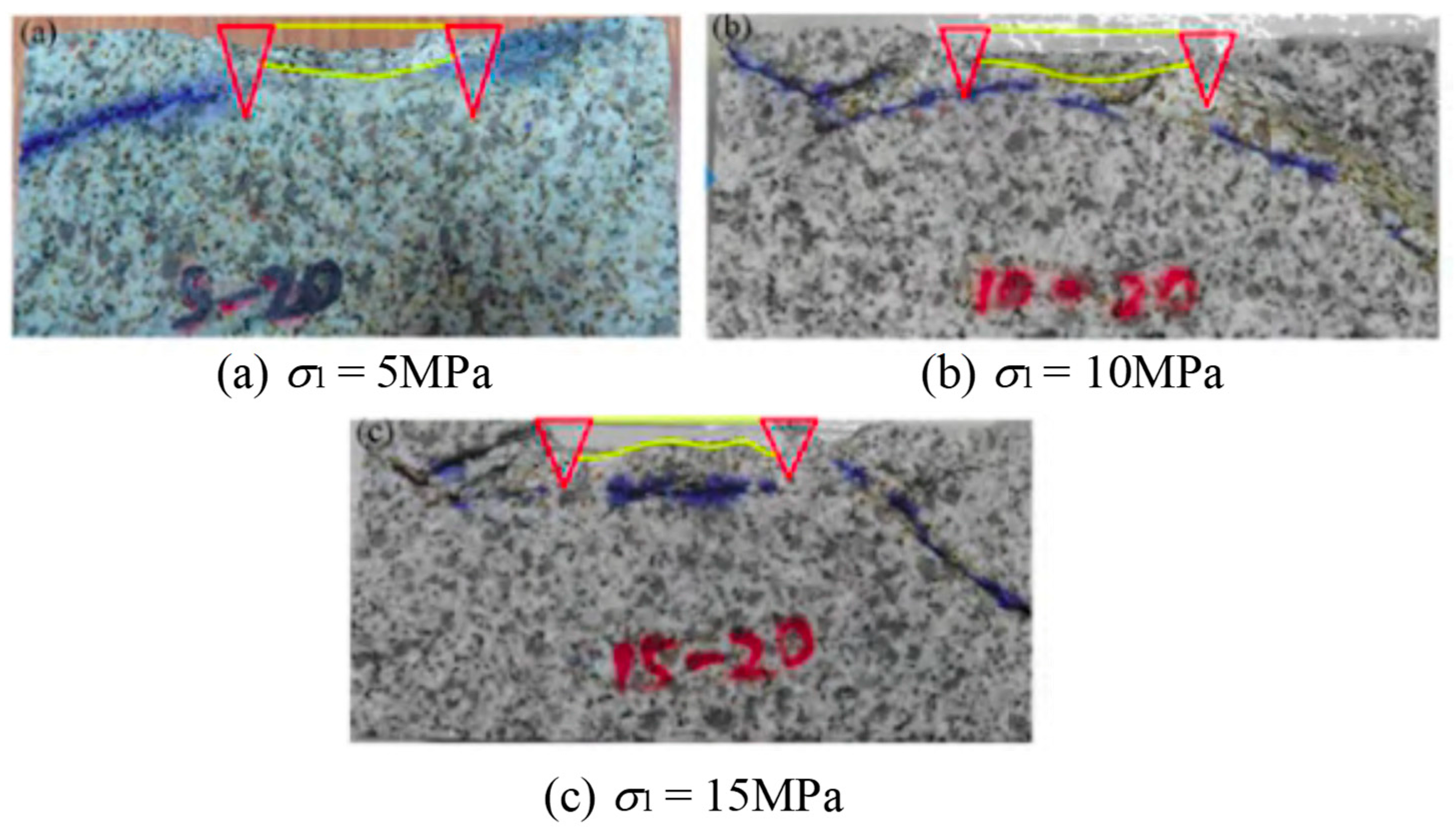
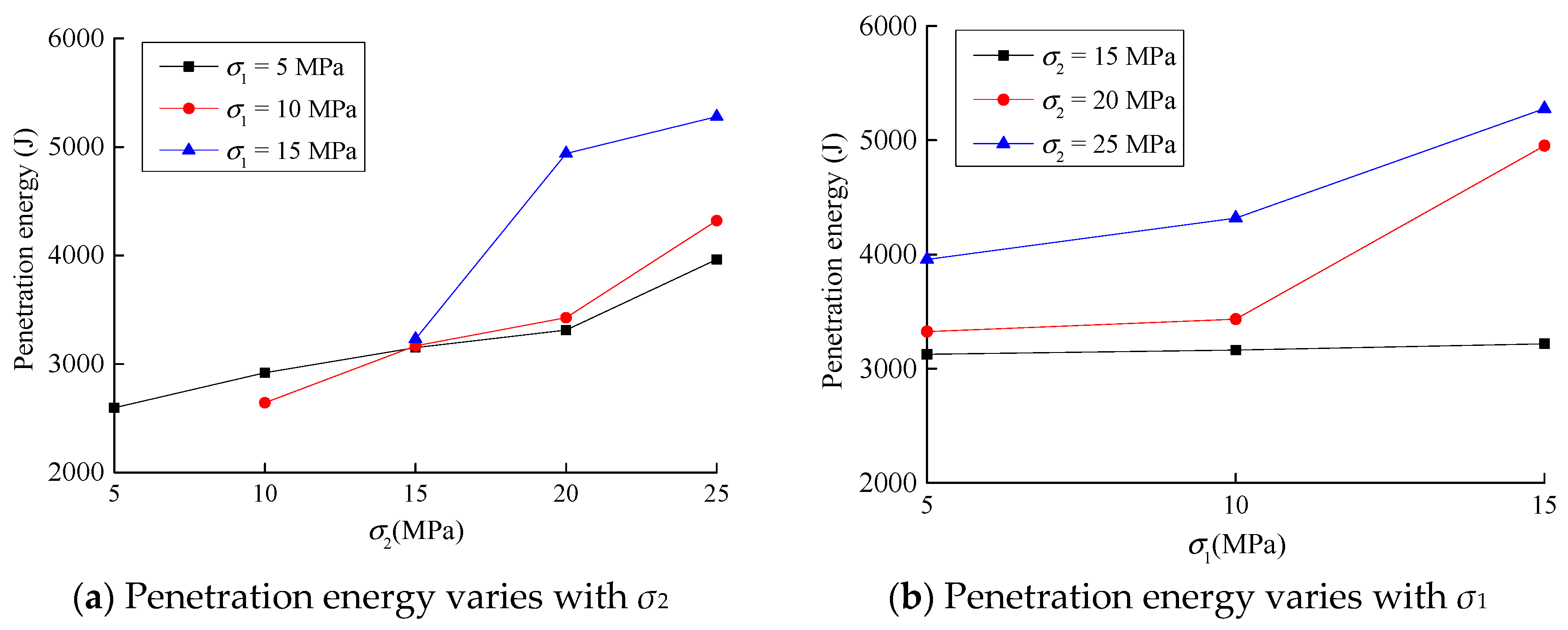
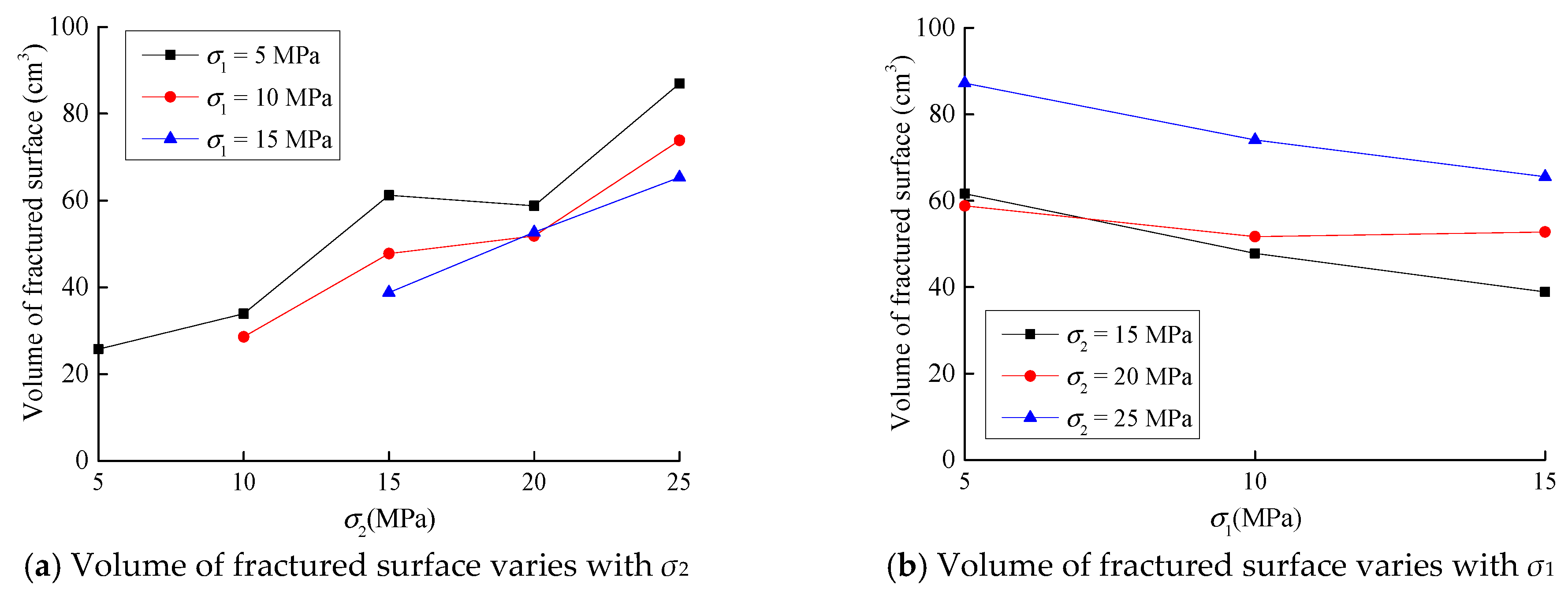
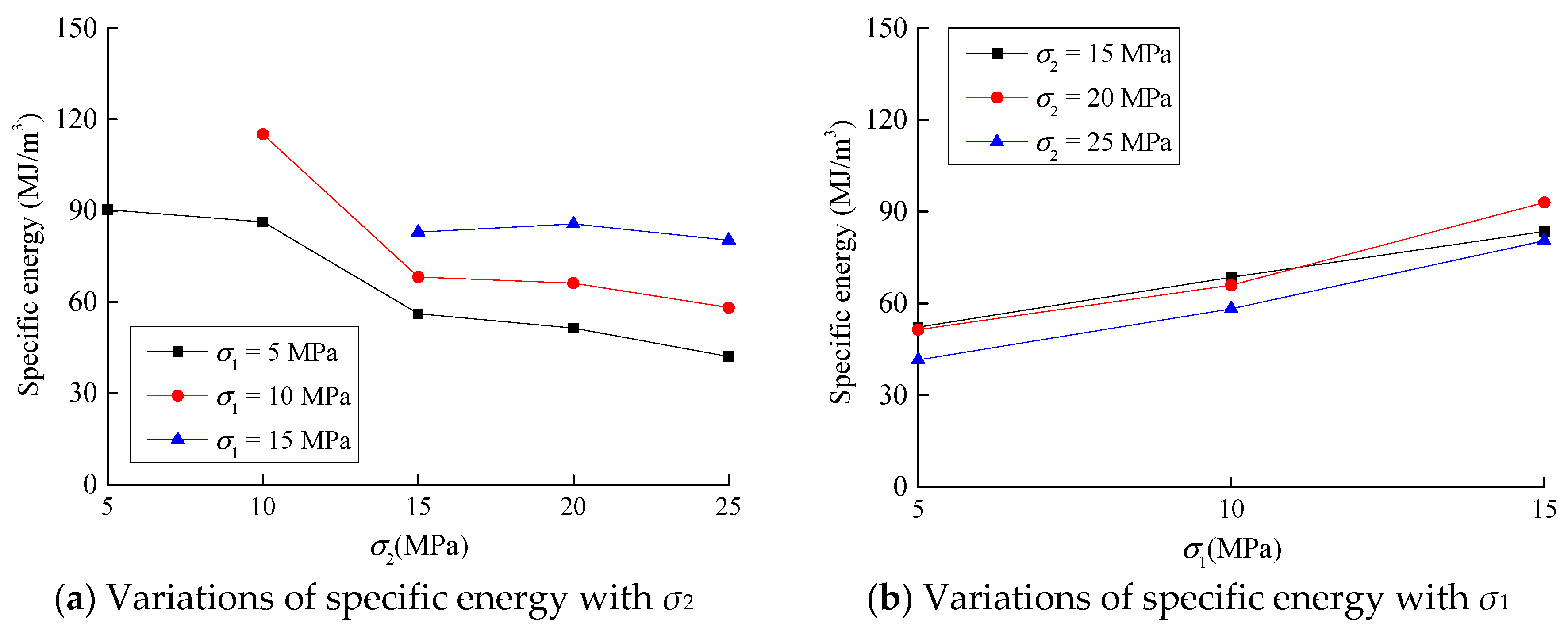
| σ1 (MPa) | σ2 (MPa) |
|---|---|
| 5 | 5, 10, 15, 20, 25 |
| 10 | 10, 15, 20, 25 |
| 15 | 15, 20, 25 |
© 2018 by the authors. Licensee MDPI, Basel, Switzerland. This article is an open access article distributed under the terms and conditions of the Creative Commons Attribution (CC BY) license (http://creativecommons.org/licenses/by/4.0/).
Share and Cite
Chen, Y.; Song, C. Rock Fragmentation Characteristics by TBM Cutting and Efficiency under Bi-Lateral Confinement. Appl. Sci. 2018, 8, 498. https://doi.org/10.3390/app8040498
Chen Y, Song C. Rock Fragmentation Characteristics by TBM Cutting and Efficiency under Bi-Lateral Confinement. Applied Sciences. 2018; 8(4):498. https://doi.org/10.3390/app8040498
Chicago/Turabian StyleChen, Yulong, and Chenpeng Song. 2018. "Rock Fragmentation Characteristics by TBM Cutting and Efficiency under Bi-Lateral Confinement" Applied Sciences 8, no. 4: 498. https://doi.org/10.3390/app8040498




